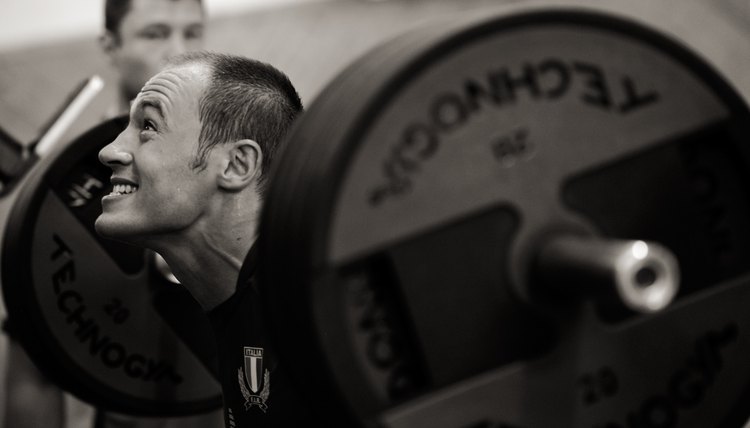How to Squat 300 Pounds

Hitting 300 pounds on the squat is a big milestone for many lifters. Being able to squat heavy will develop strength in your glutes, hamstrings and quadriceps, increase your lower body power and boost core control. Squatting 300 pounds won't happen overnight though. You need to make sure your technique is perfect, that you have a structured training plan in place and above all, have dedication, patience and determination. Do not attempt to squat this much weight without a spotter.
Learn the correct technique. To get the most from your squat, you must adopt a powerlifting stance, which is different to how you may currently be doing squats. Your feet should be wider than shoulder-width apart, with knees and toes turned out slightly. Instead of simply squatting straight down, push your hips back as far as you can and force your knees out. This will allow you to get lower and place more of the focus on your glutes and hamstring muscles, which are stronger than the quadriceps.
Perform squats twice a week. Most powerlifting strength programs prescribe training main exercises one to three times each week. Make one of these sessions a maximum effort workout, where you work up to one heavy set of three to six repetitions. The other session should be three days later and will focus on speed and explosive power. This is known as a dynamic effort session and is a staple in powerlifting routines. Strength coach Chad Smith, holder of a 905-pound raw squat, recommends using between 60 and 75 percent of your one rep max -- the heaviest amount of weight you can lift for one rep. Keep the reps low and sets high -- six to eight sets of two to three reps works well.
Add box squats to your routine. These are like normal squats, but instead of squatting to depth, place a low squat box behind you and squat to that. Touch the box with your butt, pause for a second while maintaining tension through your lower body and explode back up again. Box squats are one of the best exercises for building your posterior chain muscles -- the glutes, hamstrings and adductors -- claims Eric Cressey, owner of Cressey Performance in Massachusetts. Do these after your dynamic squats for three to five sets of six to eight. If you don't have a squat box, use an aerobic step.
Follow a periodized training plan. The most common form of periodization in strength training programs is block periodization. To begin, perform four weeks of squat training using light weights and high reps -- five to six sets of 10 to 15 reps. In the second four-week phase, increase your weights to around 75 to 90 percent of your one rep max and do three to five sets of six to eight. Finish with a two-week cycle in which you try to break your personal records. Take a week off, then return to phase one, using heavier weights than before. Keep following this cycle until you hit your 300 pound goal.
Tips
Ask a trainer or powerlifting coach for assistance if you're struggling with your squat technique.
Make small goals leading up to your ultimate goal of 300 pounds.
Warnings
Check with your health care provider before starting a training plan.
References
Writer Bio
Mike Samuels started writing for his own fitness website and local publications in 2008. He graduated from Peter Symonds College in the UK with A Levels in law, business and sports science, and is a fully qualified personal trainer, sports massage therapist and corrective exercise specialist with accreditations from Premier Global International.
